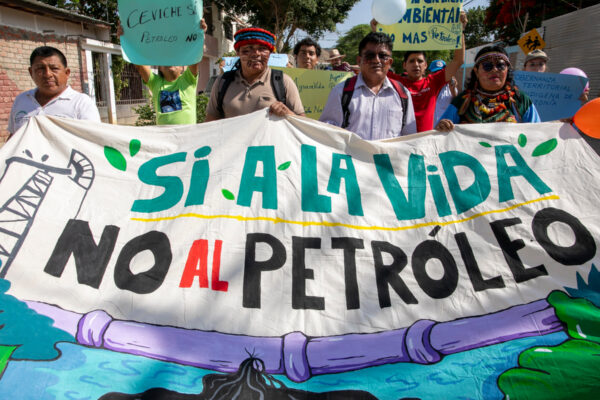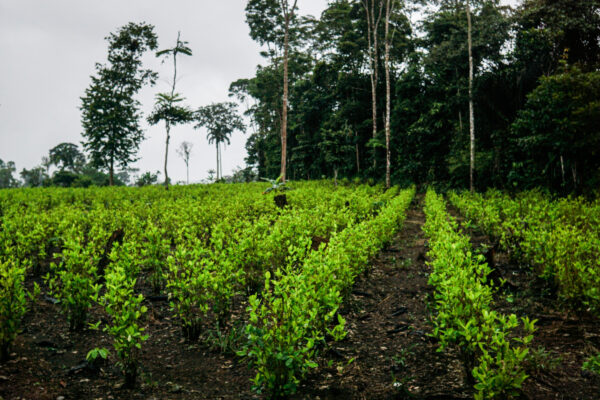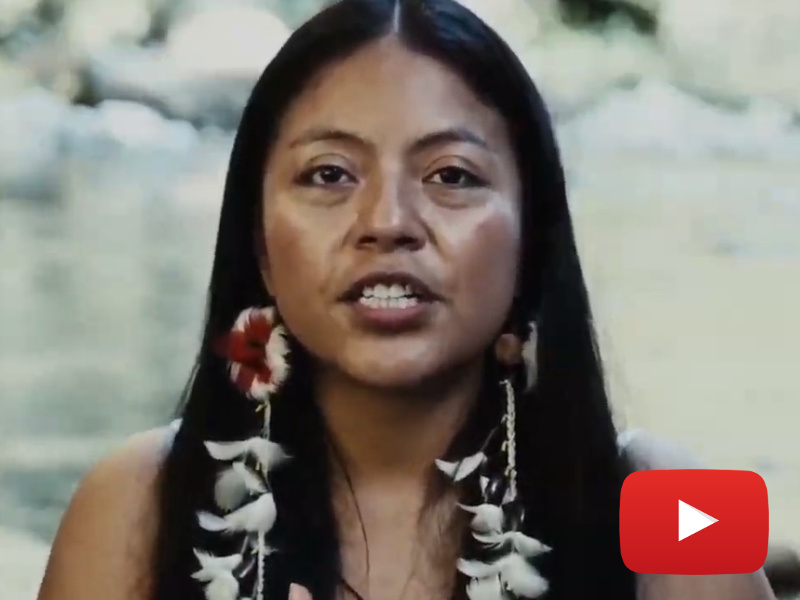“We are the ones who care for nature,” says Alessandra Munduruku, a young Munduruku indigenous leader in the Brazilian Amazon. “It isn’t someone coming from on high who’s going to teach us about caring for the forest.” Alessandra first joined her community’s fight for survival when it was threatened with flooding by the São Luiz de Tapajós mega-dam project. Although plans for the dam are shelved for now, Alessandra says the Munduruku still face threats to the survival of their culture and community.
One unexpected menace: President Donald Trump’s bluster over tariffs and trade, which pushed up the price of Brazilian soybeans earlier this year. Since the Amazon region is a hub for soybean production, the price increase could lead to greater deforestation there. Now, with the U.S. already imposing $50 billion in tariffs on China; the Chinese retaliating equally; and Trump threatening another $200 billion in tariffs, an all-out trade war looms. The repercussions of such a war would threaten the Munduruku and the Amazon.
“What affect us directly are the railway, the canal, the ports,” Alessandra says. “There are three [ports] already, and they want to build twenty more.” She is referring to the new transportation infrastructure and grain silos that dot the shore of the Tapajós River, an important Amazon River tributary, and the home territory of the Munduruku. Those silos are filled with soy being transported from Mato Grosso state, in Brazil’s interior.
The expansion of industrial agribusiness, especially beef and soy production, in Mato Grosso and other Amazon states is steadily cutting away at the Amazon rainforest. This, along with the construction of infrastructure to support moving these products to market, is putting increased pressure on indigenous and traditional communities that inhabit the region. Researchers also point to the neighboring, lesser-known Cerrado biome as another deforestation hotspot; it too is home to numerous indigenous groups and site of a Brazilian soy and cattle boom.
Even though Trump’s escalating U.S./China trade war has yet to fully make its international effects felt, it may already be impacting Brazil’s forests negatively. Data from the rainforest monitoring organization Imazon, shows a surge in deforestation between February and April of 2018 compared to last year. That timeline aligns with the President’s first threat of tariffs against China made in January.
In March, Trump officially announced $50 billion in tariffs on Chinese goods coming to the United States. Beijing struck back by declaring $300 billion in taxes on U.S. products headed to China, including soybeans. As of May 10th, U.S. soybean sales to China were down by roughly 70,000 metric tons compared to the same period last year. This drop suggests that Chinese buyers have been seeking other suppliers just to be safe, no matter whether the trade war is on or off.
Analysts say that Brazil is positioned to replace at least part of the soybeans China ordinarily buys from the U.S. as President Trump provokes the Asian trading giant’s ire. Brazil already expects to ship 56 million metric tons of soybeans to China this year, with the Amazon region and the Cerrado providing much of that amount. This year, experts expect Brazil to edge out the United States as the world’s largest producer of soybeans, growing 117 million tons.
Likely in preparation for a big boost in China/Brazil commodities trade, the Chinese in 2017 offered the Brazilians a $20 billion infrastructure investment fund package, which could pay for new roads, railways and industrial waterways for soy transport – likely leading to more Amazon deforestation and more disruptions of indigenous life.
Experts can clearly point to industrial agribusiness and the global trade in soy as a contributor to deforestation in the Brazilian Amazon. For example, forest watchdog Imazon correlates a drop in Amazon forest clearing last year to a decrease in commodity prices, including both beef and soybeans. This is the opposite of what is happening currently.
Importantly, Amazon deforestation could trigger significant climate impacts not just in South America, but around the world. Scientists reported in Nature Climate Change that cutting down large numbers of trees in the tropics can adversely affect rainfall patterns in other parts of the world. More sobering still, renowned researchers Tom Lovejoy and Carlos Nobre warned this March that Amazon deforestation, currently around 17 percent, if pushed to 20-25 percent could result in the passing of a climate tipping point that would reduce Amazon rainfall and lead to the conversion of large swathes of rainforest to savanna. That loss of the Amazon’s ability to store vast sums of carbon could dramatically increase greenhouse gas emissions, escalating climate change to dangerous levels.
Still, Jair Schmitt, Director of Brazil’s Department of Forests and Deforestation Prevention, has faith in current protection measures aimed at curbing future deforestation. These include the country’s forest code and the Soy Moratorium, a voluntary agreement arrived at by agribusiness, environmental NGOs led by Greenpeace, and the government. “Even if the demand for products can influence deforestation, it’s the market itself that is putting restrictions on illegal deforestation,” Schmitt says.
The Soy Moratorium was launched in 2006 with the aim of preventing the spread of new soy plantations into the rainforest, and to directly prevent forest clearing to make way for soy. That agreement has kept new deforestation for soy production to below 1 percent in the Brazilian Amazon, but it hasn’t ended forest clearing.
Critics of the Soy Moratorium say that the agreement contains large loopholes. One example: land thieves clear native forests, move cattle onto the land, then sell those pastures to soy growers, a multi-step process not counted under Soy Moratorium rules. Likewise, with the 2012 Brazilian forest code, which was recently weakened substantially by a Brazilian Supreme Court decision, according to experts.
While the world has shone a spotlight on deforestation in the Amazon, it isn’t the only region where trees are felled for soy. The Cerrado, the vast savanna in north-central Brazil is presently seeing the nation’s most rapid shift from native vegetation to soy, cotton, corn. Dr. Holly Gibbs, a supply-chain researcher at the University of Wisconsin-Madison, calls the Cerrado the new deforestation “hotspot.”
“Soy is a relatively minor cause of deforestation in the Amazon” today, Gibbs says, with “cattle ranching account[ing] for 60-80 percent of the new deforestation.” Yet, because areas initially cleared for livestock can later be transformed to soy fields, that deforestation story isn’t so cut and dry. Adding to that complexity, soybeans also provide important fodder for livestock, enmeshing the two commodities further. Another complication: if Trump’s tariffs result in the Chinese imposing retaliatory tariffs on U.S. beef, the Chinese might then up purchases of Brazilian beef. China and other Asian nations have seen their beef consumption and imports soar in recent years – more potential bad news for the Amazon.
Gibbs’ research found that even with the Soy Moratorium, more than 600 soybean farms violated the country’s forestry laws and cleared forestland illegally. The study reviewed satellite images of the Amazon gathered between 2001 and 2014 and of the Cerrado between 2001 and 2013. In addition, only 115 of those farms were banned from selling soy because of loopholes in the agreement. The Soy Moratorium only covers the portion of a plantation where soy is grown, and not the entire farm. Loopholes such as this leave wiggle room that allow for more tree removal, say environmentalists.
Conservationists also warn against the rapid expansion of infrastructure needed to ship commodities. New roads, railways and industrial waterways directly cause Amazon deforestation, while also dramatically increasing rainforest access for land thieves, illegal loggers, cattle ranchers, soy growers, mining operations, and new settlers.
One organization that is challenging unregulated agribusiness growth is Instituto SocioAmbiental (ISA), the Socio-Environmental Institute, an NGO dedicated to social and environmental justice. ISA’s Rodrigo Junqueira says the prospect of a U.S./China trade war is exciting soybean growers: “[They] are betting that an increase in demand is going to put pressure on the market, and so whatever [legal] restrictions exist will be dropped.
“If the demand increases, and Brazil becomes a more important supplier as a result, soybean cultivation will increase in the Cerrado and the parts of the Amazon that are suitable,” Junqueira maintains. He adds that a surge in global soy demand will almost certainly produce “a territorial dynamic that will lead to new deforestation.”
For Alessandra Munduruku, agribusiness expansion poses an existential threat to the Munduruku people. “The fight is for our land. The fight is for a little bit of land,” she says. “Even if people come to talk [to us] about forest management, capitalism comes to teach you to be ‘sustainable.’ But that mini-capitalism is where individualism begins.” Individualism, she says, with its built-in competiveness, will ultimately lead to the end of the forest, the demise of community-focused indigenous cultures, and to the end of the Munduruku.














